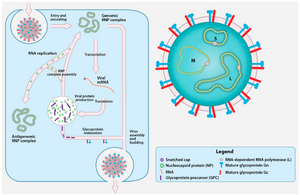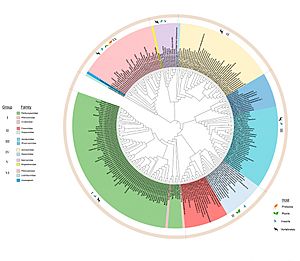Bunyavirales facts for kids
Quick facts for kids Bunyavirales |
|
|---|---|
 |
|
| Crimean-Congo hemorrhagic fever virus (CCHFV) virion and replication cycle | |
| Virus classification |
|
| (unranked): | Virus |
| Order: | Bunyavirales |
| Families | |
|
|
Bunyavirales is a group of tiny living things called viruses. They are special because their genetic material (their "instructions") is split into several pieces. These viruses can infect many different living things, including insects, plants, tiny one-celled organisms called protozoans, and animals with backbones, like humans.
The name Bunyavirales comes from a place called Bunyamwera. This is where the first virus of this type, called Bunyamwera orthobunyavirus, was found. The larger group Ellioviricetes is named after a scientist, Richard M. Elliott, who studied these viruses a lot.
Bunyaviruses have a round shape and are covered by an outer layer, like a tiny bubble. Most of them are found in insects or small animals like rodents. However, some can infect humans and plants. There are also special bunyaviruses that only infect insects.
Most bunyaviruses are spread by "vectors." A vector is an animal that carries and transmits a disease without getting sick itself. For bunyaviruses, these vectors are usually arthropods like mosquitoes, ticks, or sandflyes. Two types, Hantaviruses and Arenaviruses, are different. Hantaviruses spread through contact with rodent droppings. When vectors are active, like mosquitoes in summer, more people might get infected.
Some bunyaviruses can cause serious illnesses in humans. For example, the Crimean-Congo hemorrhagic fever orthonairovirus can make people very sick and can even be deadly. Because of this, scientists study these viruses in very safe laboratories called biosafety level 4 labs. They also cause a serious illness called severe fever with thrombocytopenia syndrome.
Hantaviruses are another important type of bunyavirus that affects humans. They are found all over the world, especially in places like Korea, Scandinavia, Russia, and parts of North and South America. Hantavirus infections can cause high fever and problems with the lungs. How dangerous they are depends on the specific type. Some can be very serious, while others are milder.
Contents
How Bunyaviruses Are Built
What Do Bunyaviruses Look Like?
Bunyaviruses are shaped like tiny balls and are covered by an outer layer. They are very small, about 80 to 120 nanometers across. To give you an idea, a nanometer is one billionth of a meter! You would need a very powerful microscope to see them.
Their Genetic Instructions (Genome)
Bunyaviruses have their genetic instructions, called a genome, split into two or three pieces. These pieces are made of RNA and are twisted like a spiral inside the virus. They also form a kind of circle because their ends connect.
Each piece of RNA has a special job:
- The L segment (large) carries instructions for making a protein that helps the virus copy its RNA.
- The M segment (medium) has instructions for making proteins that stick out from the virus surface. These proteins help the virus attach to and enter a host cell.
- The S segment (small) carries instructions for making a protein that protects the virus's genetic material.
Most bunyaviruses have "negative-sense" RNA. This means their RNA needs an extra step to be read by the host cell. Some bunyaviruses have "ambisense" RNA. This means parts of their RNA can be read directly, while other parts need that extra step. The total size of their genetic instructions can vary.
How Bunyaviruses Live and Grow (Life Cycle)
Bunyaviruses make copies of themselves inside the cytoplasm of a cell. The cytoplasm is the jelly-like substance that fills a cell. The virus's proteins then travel through parts of the cell called the endoplasmic reticulum and Golgi apparatus.
Once the new viruses are ready, they bud off from the Golgi apparatus. They then travel in small bubbles to the cell's surface and leave the cell to infect new ones.
How Bunyaviruses Spread
Bunyaviruses can infect many different living things. This includes insects, plants, protozoans, and animals with backbones.
Some bunyaviruses infect plants like tomatoes, melons, and raspberries. Other types only infect insects. For example, phasmavirids were first found in phantom midges and have since been seen in moths, wasps, bees, and other flyes.
Types of Bunyaviruses
Scientists have identified 477 different types of viruses in the Bunyavirales group. They are organized into 12 main families:
- Arenaviridae
- Cruliviridae
- Fimoviridae
- Hantaviridae
- Leishbunyaviridae
- Mypoviridae
- Nairoviridae
- Peribunyaviridae
- Phasmaviridae
- Phenuiviridae
- Tospoviridae
- Wupedeviridae
Diseases Bunyaviruses Cause in Humans
Here are some diseases caused by bunyaviruses in humans:
- California encephalitis virus, Jamestown Canyon virus, La Crosse encephalitis virus, Oropouche orthobunyavirus, and Snowshoe hare virus are spread by mosquitoes. (Family: Peribunyaviridae)
- Hantavirus is spread by small mammals or rodents, through their droppings. (Family: Hantaviridae)
- Crimean–Congo hemorrhagic fever is spread by ticks. Small and domestic mammals can also carry and spread it. (Family: Nairoviridae)
- Rift Valley fever is spread by mosquitoes. Bats, small mammals, and domestic animals can carry it. (Family: Phenuiviridae)
- Bwamba Fever is spread by mosquitoes. Monkeys and donkeys can carry it. (Family: Peribunyaviridae)
- Severe fever with thrombocytopenia syndrome is spread by ticks.
- Lassa fever and Argentine hemorrhagic fever are spread by rodents, through their droppings. (Family: Arenaviridae)
Because bunyaviruses have their genetic material in pieces, they can easily mix and match these pieces. This makes them able to change quickly, which can increase the risk of outbreaks.
These viruses are spread by blood-feeding insects and ticks. After someone is infected, it usually takes about two days for symptoms to appear. Often, the symptoms are like a mild flu with a fever that lasts about three days. Because the symptoms are not very specific, bunyavirus infections are often mistaken for other illnesses, like malaria.
How to Prevent Bunyavirus Infections
Preventing these infections depends on the specific virus and how it spreads. This includes knowing which animals carry the virus and whether it's spread by ticks or mosquitoes.
General ways to prevent infection include:
- Practicing good hygiene.
- Limiting contact with animal saliva, urine, feces, or bedding, especially from rodents.
Currently, there is no widely available vaccine for bunyaviruses. Scientists take special safety measures when studying these viruses. For example, research on Cache Valley virus and Hantavirus is done in BSL-2 labs (or higher). Rift Valley Fever virus research is done in BSL-3 labs (or higher). And Congo-Crimean Hemorrhagic Fever virus research is done in BSL-4 labs, which are the safest.
Important Dates in Bunyavirus History
1940s: Crimean–Congo hemorrhagic fever is first found in Russia.
1951: Over 3,000 cases of Hantavirus are reported in South Korea during the Korean War.
1956: Cache Valley virus is discovered in mosquitoes in Utah, USA.
1960: La Crosse virus is first identified in a deadly case of brain swelling in La Crosse, Wisconsin.
1977: Rift Valley Fever virus causes a large outbreak in Egypt, with about 200,000 cases and 598 deaths.
2017: The Bunyavirales group is officially created and named.
See also
 In Spanish: Bunyavirales para niños
In Spanish: Bunyavirales para niños




